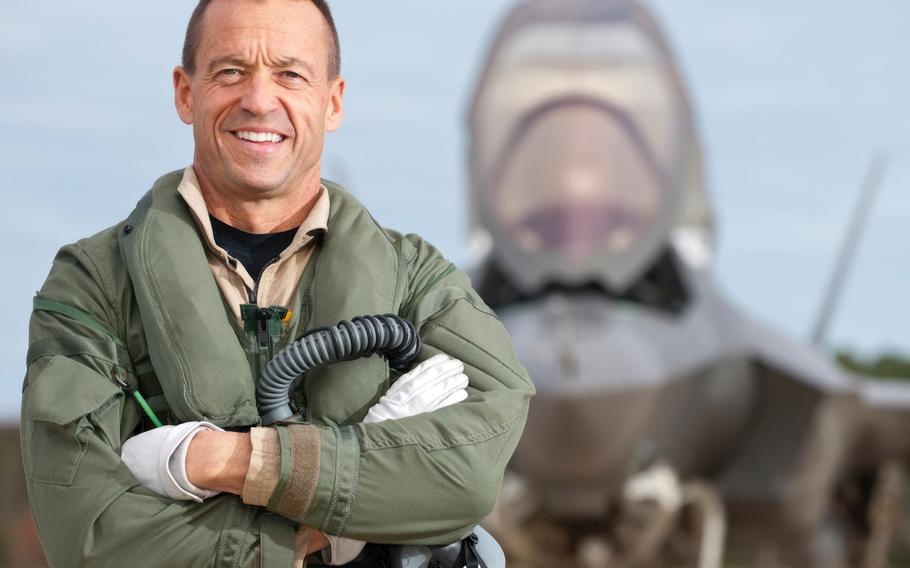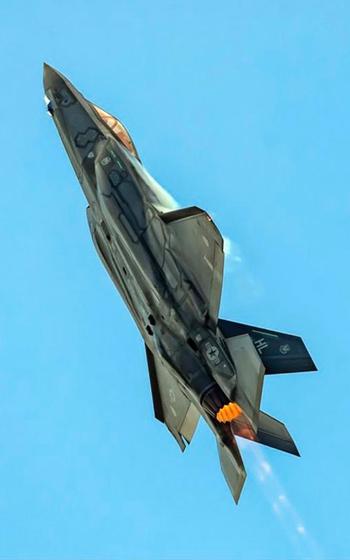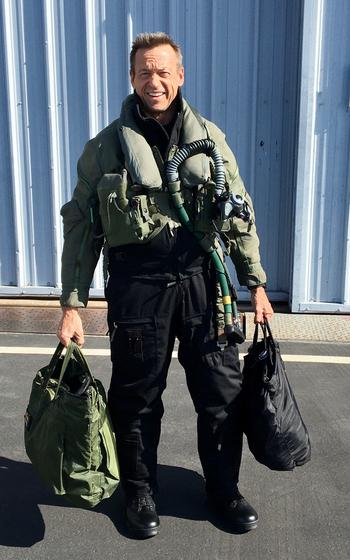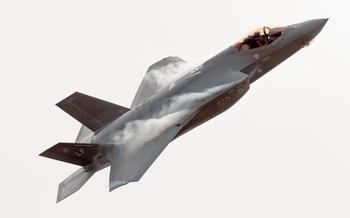Sponsored Content
Optimizing Human Performance in Fighter Jets
https://billieflynn.com/ July 31, 2025

Billie Flynn, F-35 Senior Test Pilot (Retired) (https://billieflynn.com/)
Source
In the world of military aviation, discussions about fighter jets invariably center on technical specifications and combat capabilities. We analyze speed, range, maneuverability, G-force tolerance, weapons payload, and lethality with scientific precision. War games pit aircraft against each other in complex simulations, calculating missile effectiveness and predicting battle outcomes based purely on physics. Yet in all these sophisticated analyses, we consistently overlook the most critical variable in any combat engagement: the human being flying that aircraft.

Billie Flynn demonstrating the F-35A at the Paris Air Show (https://billieflynn.com/)
Source
This oversight represents a fundamental flaw in how we approach modern air combat. We naively assume that every pilot will maximize their fighter’s lethality each time they fly, without ever measuring how individual men and women perform under combat conditions. We have never systematically evaluated the effectiveness of two-person crews or considered whether one strong crew member can compensate for another’s poor performance. Most critically, we have ignored a basic physiological reality that has compromised pilot performance for decades.
The uncomfortable truth is that even the most advanced $100 million F-35 Lightning II becomes significantly marginalized when its pilot is not operating at peak physical and cognitive capacity. All our investments in sophisticated 5th Generation fighters become meaningless if the human in the cockpit is compromised. The overwhelming technological advantage of modern aircraft evaporates when pilots cannot maintain focus during long-duration missions, especially those where high-intensity combat occurs many hours after takeoff. The question we should be asking is not just how capable our aircraft are, but whether our pilots are physically ready, sufficiently hydrated, physiologically sound, and cognitively sharp enough to fully exploit that capability.
For decades, fighter pilots have systematically cheated their bodies by avoiding proper hydration before flights, all to circumvent the awkward and seemingly impossible task of urinating while airborne. This practice has created what military aviation experts call “Tactical Dehydration,” a condition that fundamentally undermines combat effectiveness. The act of urinating in a fighter cockpit is genuinely cumbersome and time-consuming in an environment where free time is virtually nonexistent. When pilots must wear multiple layers of clothing, immersion suits for flights over cold water, or arctic gear for winter operations, the act of relieving oneself becomes nearly impossible to manage safely.
The historical solutions available to aircrew have been woefully inadequate. Men have relied on systems that evolved from primitive condom-based devices attached to collection bags around their boots, affectionately known as ‘Texas catheters’, to the infamous ‘piddle pack’ – essentially a plastic freezer bag containing absorbent material. Women have faced even fewer options, with adult diapers representing their only viable solution. The process of using a piddle pack requires pilots to safe their ejection seats, unstrap, navigate through potentially multiple layers of flight gear and harnesses, complete the task, and then reverse the entire process to re-suit, re-strap, and re-arm their ejection seats. This awkward, time-consuming procedure has led most pilots to adopt a different strategy: they simply avoid the need entirely.

Billie Flynn pre-flight with winter flying ensemble (https://billieflynn.com/)
Source
Instead of properly preparing their bodies for the rigors of combat missions through adequate nutrition and hydration, pilots have learned to stop consuming liquids hours before flight and ensure that urination is their final act before walking to their aircraft. The consequences of this approach are severe and well-documented. Men and women routinely fly seven to eight-hour combat missions without urinating, with some extreme cases lasting even longer. I once flew a 10-hour transatlantic flight from Texas to Spain with a foreign pilot in my backseat who refused to relieve himself during the flight and arrived at the far end essentially incapacitated and unable to function.
The dangers extend beyond mere discomfort. Attempts to use piddle packs have directly caused aircraft accidents. In March 1991, an F-16 fighter was lost when the pilot’s lap harness became lodged against the aircraft’s side stick while he was attempting to use a piddle pack. The lodged harness drove the aircraft out of control, forcing the pilot to eject while the fighter crashed just 300 feet from the civilian aircraft terminal in Palmdale, California. This incident starkly illustrates how the lack of proper bladder relief solutions creates safety risks that extend far beyond individual pilot comfort.
The physiological impact of Tactical Dehydration is profound and measurable. When the human body reaches just 3% dehydration, its ability to withstand G-forces drops by 50%. This dramatic reduction in G-tolerance means that pilots become unable to handle the forces generated during aggressive maneuvering and dogfighting, leading to G-induced loss of consciousness. More than a dozen documented accidents have been directly linked to tactical dehydration and the resulting loss of consciousness. No military commander has ever knowingly sent fighter pilots into combat operating at only 50% of their G-force capacity, yet this has been the reality for decades.
This situation creates a strategic vulnerability that effectively gifts our adversaries an advantage they have not earned through superior technology or tactics. Enemies no longer need to match the capabilities of our advanced fighters; they only need to perform better than our self-compromised pilots. We have essentially undermined our own technological superiority through an entirely preventable physiological limitation.
The irony is particularly stark when we consider the enormous resources dedicated to pilot training. We create elaborate, progressive training programs to perfect the flying and tactical skills of our aviators. We invest in realistic training environments and embrace the principle of “train like you fight, fight like you train.” Yet despite this massive expense and effort, we send our forces into actual combat missions operating below optimal capacity. All that sophisticated training becomes compromised because pilots fear having to urinate and choose dehydration over using inadequate relief systems.
The parallel to civilian athletic performance is instructive. We would never expect marathon runners, mountain climbers, or professional athletes to perform at their peak while deliberately dehydrated. We provide water, sports drinks, and nutrition support for far less demanding physical activities than combat aviation. Yet somehow, when flying $100 million fighters where lives are at risk even during peacetime training, we have institutionally accepted the practice of draining pilots’ bodies of the liquids and nutrients they need to function optimally.
This represents a fundamentally 20th century mindset applied to 21st century warfare. The result is that our most advanced fighters are effectively reduced to 4th Generation capability because we have marginalized the human component of the weapons system. The F-35’s revolutionary capabilities become academic when the pilot cannot access them due to physiological limitations we have imposed on ourselves.

F-35A Overhead, JRB Fort Worth (https://billieflynn.com/)
Source
Fortunately, innovative technology has emerged to address this critical gap. Omni Defense Tech’s SKYDRATE system represents the third generation of in-flight bladder relief technology and was developed through years of aircrew input and continuous improvement. For male pilots, the system consists of what is essentially an athletic protective cup, like those used in hockey or baseball, connected to a hose leading to a collection bag. The sophisticated element lies in the sensor technology embedded within the cup and hose connection, which detects the saline content in urine and automatically activates a pump to draw liquid away from the body and deposit it safely in the collection bag. Years of pilot feedback have resulted in simple switch controls, fool-proof fitting systems, and pump rates capable of handling any physiological demand.
For female aviators, SKYDRATE offers an even more revolutionary solution. The system features anatomically designed coverage that extends from front to back, with an inflatable pad that forms a seal around the lower body. Like the male system, it automatically detects urine and removes it from the body into a collection bag, ensuring zero leakage upon completion. This represents the first truly viable solution for women in combat aviation, replacing the inadequate diaper-based systems that have limited female pilot performance for decades.
The development and testing history of this technology demonstrates its reliability and effectiveness. We tested the first generation, originally called AMXD, on F-35 aircraft in 2015 at NAS Pax River. The second generation, AMXDmax, was successfully deployed during the 2020 Finland HX fighter competition, performing flawlessly during transatlantic flights in arctic conditions. For over ten years, F-35s have been ferried from Fort Worth, Texas to destinations worldwide with ferry pilots using iterations of this system. The current third-generation SKYDRATE is now in active use by U.S. aircrew and represents the only in-flight bladder relief system that has been thoroughly tested and approved for military aviation use.
The strategic implications of this technology extend far beyond individual pilot comfort. With reliable in-flight bladder relief capability, pilots can now maintain proper hydration throughout long-duration missions, optimize their nutrition without fear of physiological consequences, sustain peak G-force tolerance during combat maneuvers, maintain cognitive sharpness during extended operations, and focus entirely on mission objectives rather than physical discomfort. This transformation enables pilots to function as what military experts now term “Tactical Athletes” – highly trained professionals who maintain peak physical and cognitive performance in the most demanding environments.
The timing of this technological advancement is particularly crucial as we face the growing threat from numerically superior adversaries. In future conflicts, our forces will likely be outnumbered, making it essential that every pilot performs at absolute peak capacity. We cannot afford to send aircrew into combat operating at reduced effectiveness due to preventable physiological limitations. SKYDRATE eliminates tactical dehydration, ensuring that our most expensive and sophisticated aircraft operate with pilots who can fully exploit their capabilities.
The broader lesson extends beyond aviation to military human performance optimization in general. We have finally recognized that the human component of our weapons systems requires the same attention to detail and technological support that we provide to the mechanical components. This represents a fundamental shift in military thinking, acknowledging that peak human performance is not just desirable but essential for maintaining technological superiority in modern warfare.
The development of reliable in-flight bladder relief technology represents more than a solution to an embarrassing problem; it symbolizes a new understanding of integrated human-machine performance in military systems. By addressing this basic physiological need, we have removed a significant barrier to pilot effectiveness and restored the full potential of our most advanced aircraft. The days of choosing between proper hydration and mission effectiveness are finally over, replaced by a new era where human and machine capabilities are truly optimized together.
As we face an uncertain future with increasingly sophisticated adversaries, every advantage matters. SKYDRATE and similar human performance technologies ensure that our investment in advanced aircraft is matched by equal attention to the humans who operate them. This holistic approach to military aviation represents not just technological progress, but a fundamental evolution in how we conceptualize and optimize the human element in modern warfare.